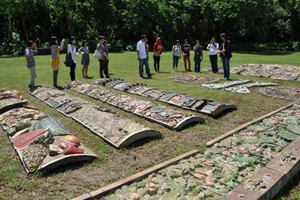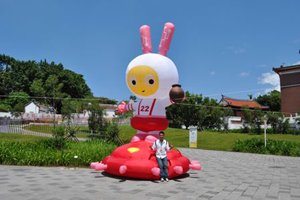When archaeological excavation runs into art
By Gloria Cho In 1897, Japanese scholars uncovered, among other utensils used in ancient times, a shell mount, gradually formed from the remains of shellfish which was originally used for food. They discovered the remnants of Yuanshan culture, and the Yuanshan Prehistoric Site is of significant importance because it covers several cultures spanning from the Paleolithic Age to the Neolithic Age. Hence, the Yuanshan Prehistoric Site had boosted the amount of archaeological studies in the area ever since, rated as a 1st grade historical site by the government in 1988 and later as a national historical site in 2006. "People of Yuanshan Culture even developed burial customs as arranged human bones unearthed proved," said Kuo, Su-chiu, associated researcher at the Institute of History and Philosophy of Academia Sinica. Thousands of years later, the Taipei Children's Recreation Center and Flora Expo Yuanshan Park now sits to the south of the ancient Yuanshan site. Both are ideal choices for family fun. From now until October 6, visiting Yuanshan can be an educational and recreational outing while artistic exhibits and free tours are being offered. Overall, three artists have created five pieces of work to examine the site from the various perspectives of past, present, and future. Decoding Taiwan The piece is an arrangement of the unearthed antiquities, consisting of six pillars, rounds, and other shapes. Looking closer, you'll discover under the ancient-like appearance carries notable features of modern Taiwan including an orchid, Taiwanese snacks, watermelons, trains, and even a computer mouse. "Secret codes" was adopted as the theme partially due to the many materials that were donated by locals, explained artist Tu, Wei-cheng. Keys, toys, and small parts are infused into the artwork that vividly portrays modern Taiwan. Upon the six pillars rest dozens of moth orchids, a popular export of early Taiwan which had, in certain degree, made Taiwan known to the world. "Therefore, it is a significant symbol of Taiwanese spirit," said Tu. In the center of the exhibit, the round-shaped plate illustrates the unique open air banquet culture in Taiwan. Elements such as the color red and culinary objects were adopted to showcase the hospitable nature of Taiwanese people while a pair of divination devices were added to reflect local religious practices. Other highlights include computer utilities to represent Taiwan's prosperous 3C industry, native plant and animal species, and much more. Tu's works often combine authenticity and unreality; modern and tradition; and new and old, in a bid to give viewers a complicated visual experience, which is a unique feature among his peers. During the exhibition period, the first 50 people who successfully take a photo of this installation while riding the MRT and upload it to the Facebook will be given a memento. This piece is later scheduled to be relocated this November or December to Terminal 2 of Taoyuan International Airport in hopes of welcoming visitors from around the world. It is said that art is a means of clarifying self-contradiction, a way to express oneself in relation to the environment, and to reflect on exterior affairs - Tu's second piece is a closer representation of his ideal. "Treasure Hunting at an Image Bank" is currently on display at the Taipei Children's Recreation Center. The bank is a collection of storage drawers containing 120 image slides of Chinese herbs found within the prehistoric site. Visitors are invited to play a game and follow clues to find the precise location of each image. The treasure-hunting journey helps people to perceive the Yuanshan site from different angles. Those who take a photo of the right location and print it out at the exhibition venue will get a surprise gift from the artist. Imaginary archaeological exploration They adopted their imagination to break established knowledge and presumptions regarding everyday objects. They unearthed objects such as shells, plastic bottles, and bulbs to create specimens and weave meaningful story out of daily waste. "Imagination is beyond everything," said Suzuki at Aug, 24th press conference, "People should never be restricted or fear to let ideas run wild. And with imagination, we finished the interesting archaeological stories." The specimens are also currently on exhibition at the Taipei Children's Recreation Center. Suzuki also set up a website to showcase the entire procedure of how the dozens of imaginary archaeologists were born. Having lived in Taiwan for years, Suzuki is talented in seizing a subtle perspective just by observing the interactions among human, society, and environment. He then uses his exploration and reflection as inspiration for his works, which can be seen in various places all across Taiwan. "Bunny" time traveler Located at the Flora Expo Yuanshan Park near the entrance of Taipei Children's Recreation Center, artist Yeh Yi-li's "Two Two" is a mischievous bunny that drives a time-machine and travels through time and space to collect various treasures. The 7-meter high bunny has a pair of electronic ears that can sense the year an object is made, and a can in one hand to ensure that every piece of treasure collected will reach its studio in the blink of an eye. "Two Two" will not only study the area during his stay at Yuanshan Prehistoric Site, but will also collect modern-day materials. Just as an archaeologist reproduces living scenes through legacies unearthed, Yeh joined students from several Taiwanese primary and junior high schools to complete the work "Mark 2013, Time Chest." The exhibition contains images of students' favorite landscape of Taipei today; corners at home, a sentence, or a painting are all hung along the fence outside the Yuanshan Prehistoric Site. Often, Yeh's artworks are seemingly ridiculous at first sight, but looking deeper within, they truly represent her care towards contemporary society, humanity, and ecology. Born in 1973, Yeh's creation often infuses image recording, fortuity, cosplay, and performing factors to produce unique results. She tries to explore issues such as globalization, capitalism, consuming culture, and modern isolation under the sub-culture phenomena. On-site tours To enhance citizens' understanding, a total of five free tours of Yuanshan Prehistoric Site will be arranged in September. Each tour accommodates up to 30 participants, offering professional archaeology excavation studies, visits to the shell mount (open to the public for the first time), and also a free limited souvenir of "Two Two."
Staff WriterAround 3,000 years ago when Taipei Basin was a lake, Yuanshan stood as a small island in the the northeastern corner. A group of people clustered to make a living along the lake, from which they harvested shellfish, hunted for prey, and grew their own crops.
Those who are heading to Danshui by MRT may now spot a piece of giant art displayed not long after the cart departs Yuanshan Station. Placed right upon the grassland where the precious unexcavated shell mound rests, the art piece "Discovering Taiwan Secret Code" intriguingly combines art and archaeological excavation.
 Archaeological excavation can also be approached through the imagination, just as Japanese artist Takahiko Suzuki, in conjunction with students from three primary schools in Taipei, attempted to recreate reality.
Archaeological excavation can also be approached through the imagination, just as Japanese artist Takahiko Suzuki, in conjunction with students from three primary schools in Taipei, attempted to recreate reality.  After experiencing archaeological excavation from the past and present, we now push the timeline far into the distant future, where an archaeologist travels from the future world to present earth.
After experiencing archaeological excavation from the past and present, we now push the timeline far into the distant future, where an archaeologist travels from the future world to present earth.

![Taiwan.gov.tw [ open a new window]](/images/egov.png)
